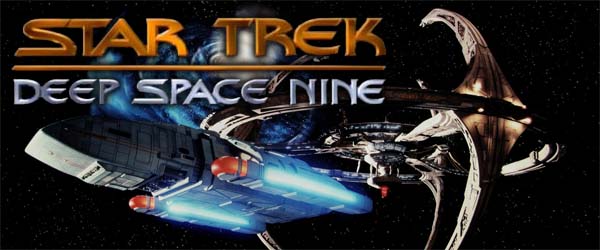
The Next Generation, Deep Space Nine, and (depending on who you talk to) Voyager are widely regarded as the "Golden Age" of Star Trek. Since many Trekkies look back at this time period of the late 80's and 90's with the rose-tinted glasses of nostalgia, it might surprise you to read that Deep Space Nine used to be a highly divisive topic among Star Trek fans. Even to this day, I've talked to "hardcore" Trek purists who dislike Deep Space Nine because of how dark and conflict-driven the series is. I can't imagine what these people must think of the Kelvin-verse reboots, Star Trek: Discovery, or Picard. If you think I'm hard on those recent iterations of Star Trek, then you should talk to these people!
In any case, the idea that DS9 is too dark and conflict-driven is a valid criticism from someone coming from the perspective of a fan of The Original Series and Next Generation. Both of those shows were about an idealistic future in which humanity had grown out of its petty squabbles and now seeks to better itself through cooperative exploration and colonization of space. Deep Space Nine didn't quite accept those ideas at face-value. Deep Space Nine's more pragmatic approach had some fans believing that Deep Space Nine violated the spirit of Star Trek.
Many fans of The Original Series and Next Generation criticized Deep Space 9 for being "too dark".
Deep Space Nine was also the first Trek series to be highly serialized, having a singular, overarching plot throughout most of the series, and with frequent mini-arcs running for half a season or a whole season. TNG had its share of recurrent story arcs. Q's "trial of humanity" was pitched as a framing mechanism for the entire show, but ended up only serving to bookend the series, while relegating most of Q's appearances each season as comic tangents. There were other recurrent sub-plots as well, such as Worf's discommendation from the Klingon Empire and his conflict with the Duras House in the "Sins of the Father" arc, the Borg story thread, Data's relationship with his brother Lore, Wesley's training as a Starfleet officer, and a few others. But TNG stayed mostly episodic. Almost all the single episodes of TNG (and the two-parters as a whole) can be enjoyed independently, without having seen any previous episodes of TNG. That was not the case with DS9.
I missed many episodes of DS9 because
it aired on weekend evenings.
DS9 was on the air throughout my elementary school and middle school years (I was seven when the show premiered). It frequently aired (syndicated on Fox in my region) on weekend evenings, and I was often outside playing tag, riding bikes, or playing touch football or street basketball with neighbor kids. As such, I missed a lot of episodes. Due to the highly-serialized nature of the show, when I would see an episode, I would have no idea what was going on! Because I rarely watched the show, and didn't understand it when I did see it, I didn't particularly like it. I'd still watch it, because it was still Star Trek. In fact, Voyager was the first Star Trek series that I watched regularly (it being on Wednesday nights, when I wasn't outside playing), and, well, you all know how I feel about Voyager.
In fact, I grew up with a bit of a preconceived notion that Deep Space Nine was the "bad" Star Trek series -- even though critics at the time largely appreciated it. On the off chance that I could talk about Star Trek with a peer, they generally didn't like DS9 either -- for many of the same reasons.
It wasn't until my college years, when the show was released for sale on DVD that I sat down and watched the whole series from start to finish. At first, I wasn't even sure if I wanted to bother buying the DVDs. After all, DS9 was "the bad Star Trek". So why spend the money? And those DVDs cost a lot of money! CBS wanted something like $120 for a single season, compared to $30 or $40 a season for shows like E.R. or Grey's Anatomy. At least the Next Gen DVDs came in fancy, sturdy boxes. The DS9 DVDs came in cheap, flimsy, rigid plastic booklets that start to fall apart as soon as you open them. I think my mom bought them from Costco for $90 a pop -- a considerable discount, but still obnoxiously expensive!
CBS wanted $120 per season for DS9 DVDs!
I was now older. I was coming to terms with my personal identity as a progressive secular humanist. Most importantly, I could finally follow along with the various multi-episode story threads and the complex, nuanced characterizations. And boy, did my opinions on the series change!
I'll always have a soft spot for Next Generation. That show has my favorite Trek character: Data. And Picard is probably my third favorite character after Spock. After my single favorite episode of Trek, the Original Series' "Balance of Terror", most of my runner-up favorite episodes are TNG episodes. Episodes like "The Measure of a Man", "Who Watches the Watchers", "The Offspring", "The Best of Both Worlds", "Deja Q", "I, Borg", "Tapestry", "The Inner Light", "Darmok", "All Good Things...", and so on...
Despite my fondness for Next Generation, I actually think that Deep Space Nine is the better all-around show.
Every Trek series since the original has taken a couple years to really find its footing. TNG doesn't really figure itself out until midway through season 2, and Voyager takes until the 4th season to figure itself out -- if ever. I don't know if Discovery ever righted its ship, since I didn't bother to watch past the first season, and Picard didn't even become watchable until the third season. I feel like DS9 finds its footing much earlier than TNG or Voyager. Deep Space Nine's characters, themes, and stories start to fall in place by the end of season 1. In fact, one of my favorite episodes of the entire series (and one of my favorite episodes of Trek in general) is a season 1 episode: "Duet". DS9 is the only Trek series (since the original) for which one of my favorite episodes comes as early as the first season.
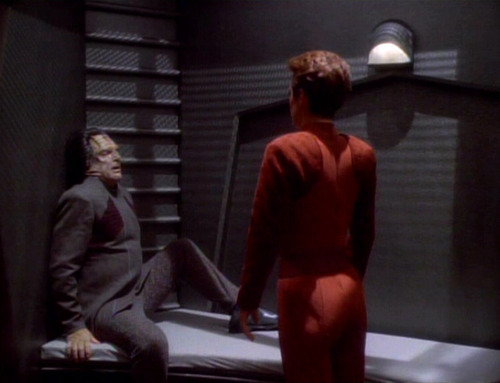 - DS9 "Duet", season 1, episode 19
- DS9 "Duet", season 1, episode 19
One of my favorite DS9 episodes (and Trek episodes in general) is the season 1 Holocaust allegory, "Duet".
The last episode of season 1, "In the Hands of the Prophets" starts to set up the season-long arcs (and a series-long arc) that would become a trademark of the series. That episode introduces us to recurring villain Vedek Winn and starts the process of her gradual accumulation of power, which we'll talk about later.
But despite the series coming together better in the first season, critics of Deep Space Nine aren't wrong when they say that it "feels different" from the Original Series or Next Generation. The show is unarguably darker and more conflict-driven. The entire second half of the series is about an interstellar war, and the seasons leading up to that repeatedly tell stories about domestic terrorism, Holocaust allegories, religious persecution, and cynical politics. These sorts of themes were present in episodes of TOS and TNG here and there, but DS9, at a fundamental level, was about these difficult topics.
[More]
79b833d8-97bd-4e2f-b45e-9f666db1588a|1|5.0
Tags:Star Trek, Star Trek: Deep Space Nine, Gene Roddenberry, Federation, Starfleet, culture, ideals, cooperation, socialism, post-scarcity economics, alien, multi-culturalism, progressivism, humanism, secularism, terrorism, war, Benjamin Sisko, Kasidy Yates, Odo, Quark, Ferengi, Klingon, Cardassian, Dominion, Bajor
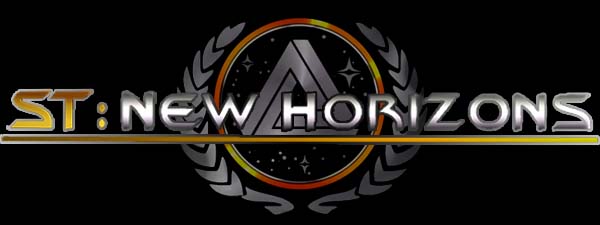
Here's something that I've never done before: a review of a game mod! I don't play mods very often. When I play games, I usually want to play the game that the creators created in order to get a feel for what their intent might have been. For some of the more sandboxy PC games that I play (like Cities: Skylines or the like), I might try some small mods.
There has yet to be an official game quite like Microprose's 1999 release, Birth of the Federation.
For this one instance, however, I'm making an exception because this particular mod fills a very specific niche desire for me that has gone unfulfilled for around 15 or 20 years. The "New Horizons" mod for Stellaris is finally allowing me to play a full 4-x strategy game set in the Star Trek universe. I haven't been able to do that since Star Trek: Birth of the Federation, developed by Microprose for Windows 98!
The creators seem to have been inspired by BotF.
Yes, there have been other Star Trek mods for other games in the past, and there's even some community projects to create spiritual successors to Birth of the Federation (such as Star Trek: Supremacy). The problem is that I've yet to ever see one of these get finished. "New Horizons" for Stellaris is still a work-in-progress, but it is mostly functionally complete and fairly robust. Since Birth of the Federation holds such a special place in my heart, I'm going to take a stab at reviewing "New Horizons" and see how it compares to my personal favorite [official] Star Trek game of all time.
Built on the back of Stellaris
"New Horizons" is, of course, a mod for the PC game Stellaris (developed and published by Paradox). Because of this, it takes advantage of most of Stellaris' strengths, but it is also hamstrung by many of Stellaris' faults.
"New Horizons" makes excellent use of the massive size and scale of Stellaris' maps by featuring a detailed recreation of the canon Star Trek galaxy, and including a surprisingly exhaustive roster of Star Trek races and factions -- all of whom are playable. Yes, of course, the big players like the Federation, the Romulans, Klingons, Cardassians, Ferengi, Dominion, and Borg are all here. As are all the expected ancillary empires like the Gorn, Tholians, Orions, and so forth.
The playable roster is surprisingly vast and exhaustive.
It doesn't end there, though. This mod also features a crap-ton of "aliens of the week" as fully-featured, playable empires. They aren't "minor races" like what we had in Birth of the Federation or the city states of Civilization V or VI. They don't just have one planet and a handful of ships just waiting for a "major faction" to conquer or absorb them. The obvious choices like the Vulcans, Andorians, Bajorans, are all there. The game also features empires like the Sheliak, Anticans, Selay, Caitian, Cheron, Dosi, Hirogen, Kazon, Krenim, Kelpian, and more! If you have a favorite space-facing civilization from any episode of Star Trek (including Gamma Quadrant aliens from DS9 and Delta Quadrant aliens from Voyager), there is a very good chance that it's a playable faction in "New Horizons"... [More]
2c39f87b-9de4-4abc-b74c-781e4f27c822|0|.0
Tags:Stellaris, Star Trek, New Horizons, Stellaris: New Horizons, mod, PC, Steam, 4x, strategy, user interface, space, exploration, war, starship, starbase, warp drive, glitch, casus belli, Star Trek: Birth of the Federation, Star Trek: the Next Generation, Star Trek: Deep Space Nine, Star Trek: Voyager, Star Trek: Enterprise, Star Trek: Discovery, Star Trek: Beyond, Star Trek II: the Wrath of Khan, Star Trek VI: the Undiscovered Country, Federation, Klingon, Romulan, Cardassian, Ferengi, Dominion, Borg, Gorn, Tholian, Orion Syndicate, Vulcan, Andorian, Tellarite, Kazon, Hirogen, Alpha Quadrant, Beta Quadrant, Gamma Quadrant, Delta Quadrant
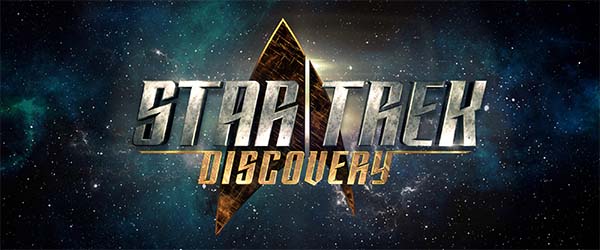
I finally sat down and binged the second half of Star Trek: Discovery's first season. I was actually excited to see it (not excited enough to sign up for CBS's All Access service), since it looked like the mirror universe twist would take the show in new and creative directions, and might even establish that Discovery would be a sort-of anthology series after all.
Boy, was I disappointed.
I was initially excited to see Discovery's mirror universe episodes.
Stakes feel artificial and exaggerated
The mirror universe storyline didn't feel like it was new or creative at all. In fact, it felt like it was retreading a lot of territory that Star Trek has covered before. Except now, they are supercharging it with stupid.
Once again, I'm not going to fuss about the show being aesthetically different from the original series. Such complaints are mostly pedantic. You can't use the same 1960's aesthetics from the original series and expect the show to look futuristic to modern audiences. I can overlook the shiny touch displays, the redesigned ships, the new Klingon makeup, the holographic communications, and things like that. I'm a bit less willing to overlook details like the insignia badge, but whatever.
I was actually a little bit excited to see the mirror universe in the second half of Discovery. After all, the mirror universe episodes of Enterprise were some of the most fun that series ever allowed itself to have. Granted, it was super fan-servicey and silly, but it had that campy charm that helped make the original series so successful. Discovery does not have any camp, or any charm.
Enterprise's "In a Mirror, Darkly" got away with its silly fan service by being charmingly-campy.
What I can't tolerate are the major anachronisms like the Klingons having cloaking devices ten years before Balance of Terror, fifteen years before The Time Trap, and twenty-eight years (give or take) before The Search for Spock. Yes, I also complained about the Romulans already having a cloaking device in Star Trek: Enterprise as well. [More]
95d074a1-40d0-4add-a244-fcf0dfd9bc46|2|3.5
Tags:Star Trek, Star Trek: Discovery, CBS, all access, streaming television, U.S.S. Discovery, science fiction, spore drive, warp drive, Klingon, Qo'nos, mirror universe, United Federation of Planets, Terran Empire, Gabriel Lorca, Jason Isaacs, Michael Burnham, Sonequa Martin-Green, Ash Tyler, Voq, Shazad Latif, Mary Wiseman, Sylvia Tilly, Doug Jones, Saru, Christopher Pike, Anson Mount, USS Enterprise, Midichlorian, Mary Sue, McGuffin
Although the components for Gale Force Nine's Star Trek: Ascendancy are generally pretty exceptional (and the expansion components are also quite high quality), I did have one major disappointment with the package: the game does not include plastic figures to represent the various faction's starbases. Instead, the game uses cardboard tokens to represent starbases. These are functionally fine, but they just don't have the presence on the board to match their strategic importance within the actual game, and it's easy for them to kind of disappear into the background of the game's map. The individual cardboard tokens don't even have art specific to each faction; all five factions have pictures of Federation starbases on the top.
The manufacturer was apparently aware of this, and, in addition to selling "expansions" containing additional ships and control nodes for each faction, they also sell a set of three plastic starbase figures for each faction.
All factions use carboard tokens for starbases, all of which have pictures of Starfleet starbases.
Since I really like the Ascendancy board game, I wanted to support the manufacturer and designers. I had already purchased all three of the game's expansions (the Cardassian faction, Ferengi faction, and Borg: Assimilation expansion), and I'll be playing and reviewing them soon. I also went ahead and bought the starbases. GF9's storefront wants $12 USD for each set of a faction's three starbase figures. That's a pretty steep price for components for a game that already costs $100 without any expansions. $12 times five factions comes to $60 (almost two-thirds the cost of the core game!). The core game's components are all pretty nice, as are the components for the Borg expansion, and the pictures of the bases looked pretty nice (even though they are unpainted). So I went ahead and made a purchase.
I was excited to have the new toys to play with -- I always like getting new games and toys. But when they showed up, a lot of that excitement was dashed. The product that had been delivered was substantially sub-par.
These are definitely not ready to be played with out-of-the-box...
Defects and poor quality
The Ferengi and Klingon bases were attached to plastic frames and had to be torn off, and the remains of the frames had to be cut off of the starbase figures in order for the figures to fit into their bases and stand on their own. One of the Ferengi figures snapped and broke while I was removing it from its plastic frame. I had to super-glue it back together... [More]
0c252a06-3e87-4d43-b75e-bc67b2ad3788|1|5.0
Tags:Star Trek, Star Trek Ascendancy, Gale Force Nine, board game, strategy, 4x, Federation, Romulan, Klingon, Cardassian, Ferengi, starbase, miniature, glue
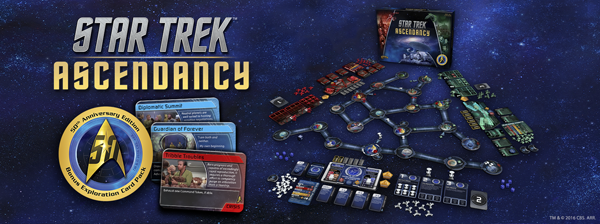
As I had mentioned in my Star Trek: Fleet Captains review, good Star Trek games are few and far between. Perhaps my favorite Trek game of all time is the Windows '98 4-x strategy game Birth of the Federation. BotF, developed my Microprose, was basically a Trek reskin of Master of Orion II. It was buggy, had cheating A.I., suffered from a major memory leak that slowed the game to a crawl after about 100 turns of play, and it didn't include any Original Series ships or technologies. But it did manage to faithfully capture Star Trek's spirit of exploration and discovery by being a game about exploring and colonizing a galaxy.
It wasn't a stripped-down startship combat simulator (Starfleet Command), or a cookie-cutter first-person shooter (Elite Force), or a lazy StarCraft clone (Armada), or an out-of-place dogfighter (Invasion), or a derivative WoW clone (Star Trek: Online). None of those games is terrible. I've played them all, and actually have some rather fond memories with most of them. But none of these games really meshed perfectly with the Star Trek license, and none of them really scratched my Star Trek gaming itch the way that Birth of the Federation did. Apparently, some designers at Gale Force Nine also like Birth of the Federation, because their new board game, Star Trek: Ascendancy, almost feels like a board game version of that classic Trek PC game.
Ascendancy is the first proper 4-x board game using the Star Trek license that I've seen. It certainly blows Fleet Captains out of the water. While Fleet Captains included some token exploration and territory-expansion mechanics as a supplement to the ship-to-ship combat that was the core of the game, Ascendancy is a game that is actually about exploring a procedurally-generated map, colonizing planets, and developing their resources. You can win by conquering other players' home worlds, or by developing your culture up to a specific level.
The final frontier is always in flux
The board of Star Trek: Ascendancy utilizes an interesting and novel modular board. Disk tiles represent planets, systems, and anomalies, each of which is connected by star lanes of varying distances. New systems and star lanes are drawn from a deck as the players explore, and so the board is constantly expanding as you play. It's nothing earth-shatteringly new, but it does have one neat gimmick that I haven't seen in other similar games.
The map will grow and change as the game progresses.
In addition to the board dynamically growing as the game progresses, systems are considered to be "floating" until they become locked in place by being connected to two or more systems via a star lane. This means that leaf systems can be freely rotated around to make room for other tiles to be placed in the play area. I believe this is intended to model the 3-dimensional nature of space. In a more practical sense, it means that the galaxy [map] can (and will) change its shape occasionally, leaving the true distances between locations ambiguous until everything gets locked down. [More]
7b9b6ce0-3004-4c0d-a534-30ff155f91cb|1|1.0
Tags:Star Trek, Star Trek Ascendancy, Gale Force Nine, board game, strategy, 4x, dice, Federation, Romulan, Klingon, exploration, phenomenon, trade, colonization, war, star lane, warp, warp drive, Aaron Dill, John Kovaleski, Sean Sweigart, Star Trek: Birth of the Federation
|

| 12 | | | | | | | 60 | | 11 | | | | | | | 55 | | 10 | | | | | | | 50 | | 09 | | | | | | | 45 | | 08 | | | | | | | 40 | | 07 | | | | | | | 35 | | 06 | | | | | | | 30 | | 05 | | | | | | | 25 | | 04 | | | | | | | 20 | | 03 | | | | | | | 15 | | 02 | | | | | | | 10 | | 01 | | | | | | | 05 |
|